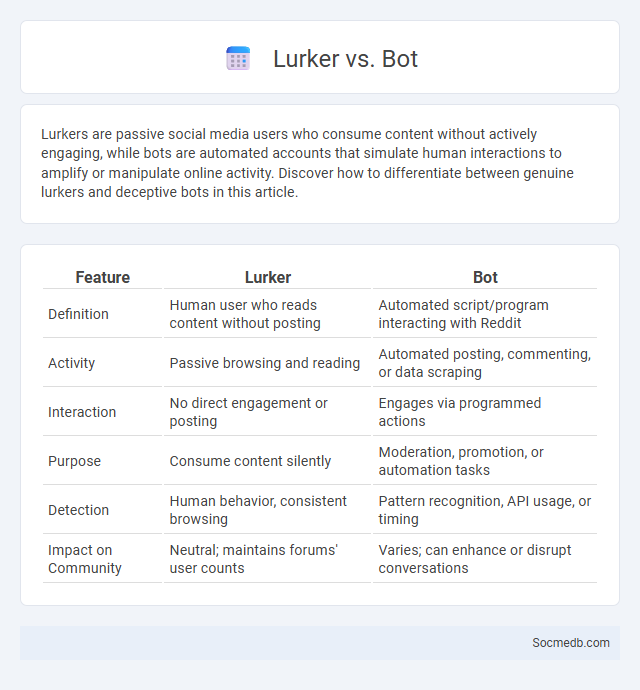
Photo illustration: Lurker vs Bot
Lurkers are passive social media users who consume content without actively engaging, while bots are automated accounts that simulate human interactions to amplify or manipulate online activity. Discover how to differentiate between genuine lurkers and deceptive bots in this article.
Table of Comparison
| Feature | Lurker | Bot |
|---|---|---|
| Definition | Human user who reads content without posting | Automated script/program interacting with Reddit |
| Activity | Passive browsing and reading | Automated posting, commenting, or data scraping |
| Interaction | No direct engagement or posting | Engages via programmed actions |
| Purpose | Consume content silently | Moderation, promotion, or automation tasks |
| Detection | Human behavior, consistent browsing | Pattern recognition, API usage, or timing |
| Impact on Community | Neutral; maintains forums' user counts | Varies; can enhance or disrupt conversations |
Introduction to Lurkers and Bots
Social media platforms host a significant number of lurkers, users who consume content without actively engaging or posting, representing up to 90% of the audience in some communities. Bots, automated software designed to mimic human behavior, contribute to content dissemination, marketing efforts, and sometimes misinformation. Understanding the roles of lurkers and bots is essential for analyzing user engagement patterns and platform dynamics.
Defining “Lurker” in Online Communities
A lurker in online communities is a participant who consumes content without actively engaging through comments or posts, maintaining a silent presence. Your understanding of lurkers highlights their role in shaping community dynamics by observing trends and gathering information without direct interaction. These members contribute to the overall activity and reach of social platforms despite their low visibility.
What is an Online Bot?
An online bot is a software application designed to automate tasks over the internet, often mimicking human behavior on social media platforms. These bots can perform activities such as liking posts, following accounts, or posting content, impacting your online interactions and engagement metrics. Understanding how online bots operate helps you manage and optimize your social media presence effectively.
Key Differences: Lurker vs Bot
Lurkers on social media are human users who consume content passively without engaging through likes, comments, or shares, making up a significant portion of platform audiences. Bots, in contrast, are automated programs designed to simulate human activity, often used to amplify messages, create fake engagement, or manipulate social metrics. Understanding the distinction between human lurkers and bots is essential for accurate social media analytics and effective platform moderation strategies.
Role of Lurkers in Social Platforms
Lurkers play a vital role in social platforms by consuming content without actively participating, which contributes to audience size and engagement metrics. Their presence often influences content creators to tailor posts based on observed reactions and trends, despite minimal direct interaction. Understanding your audience includes recognizing the silent majority whose passive behavior shapes the social media ecosystem.
How Bots Influence Online Interactions
Bots significantly shape online interactions by automating content creation, amplifying messages, and manipulating trending topics on platforms like Twitter and Facebook. These automated accounts can distort public opinion by spreading misinformation and creating artificial engagement, impacting both political discourse and marketing strategies. Understanding bot behavior is crucial for developing effective algorithms that detect inauthentic activity and protect the integrity of social media ecosystems.
Lurker vs Lurker: Unpacking Types of Lurking
Lurkers in social media vary from passive observers who consume content without interaction to strategic lurkers who gather information for specific purposes without active participation. Understanding these types reveals patterns of engagement that impact community dynamics and content dissemination. Recognizing distinctions between casual and intentional lurking helps marketers tailor strategies for audience activation and content targeting.
Common Misconceptions: Lurkers vs Bots
Many believe that all inactive social media accounts are bots, but in reality, a significant portion are lurkers--real people who observe content without engaging. Understanding the difference between these silent users and automated bots is crucial for accurately analyzing your audience's behavior and engagement metrics. Recognizing this distinction helps tailor your social media strategy to connect effectively with genuine, albeit quiet, followers.
Impact of Lurkers and Bots on Community Dynamics
Lurkers, who comprise up to 90% of social media communities, significantly influence community dynamics by shaping engagement patterns without active participation. Bots, responsible for an estimated 15-20% of Twitter accounts, can skew perceptions of consensus, amplify misinformation, and disrupt authentic user interactions. Understanding the role of lurkers and bots is crucial for maintaining genuine social media ecosystems and mitigating manipulation.
Future Trends: Evolution of Lurkers and Bots
Future trends in social media reveal a significant evolution in lurkers, who increasingly engage passively while data mining algorithms study their behavior for targeted content delivery. Simultaneously, the rise of sophisticated bots using AI enhances automated interactions, influencing trends and amplifying messages without direct human involvement. Understanding these dynamics empowers your strategy to navigate ethical challenges and optimize engagement in this rapidly changing digital landscape.
 socmedb.com
socmedb.com